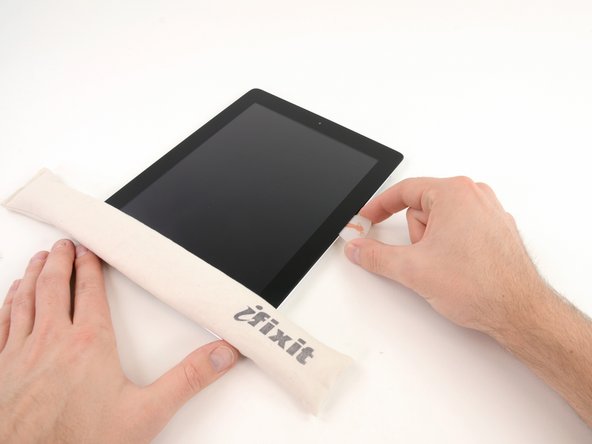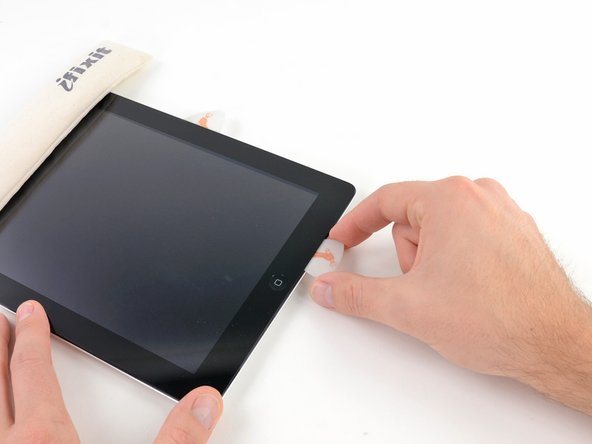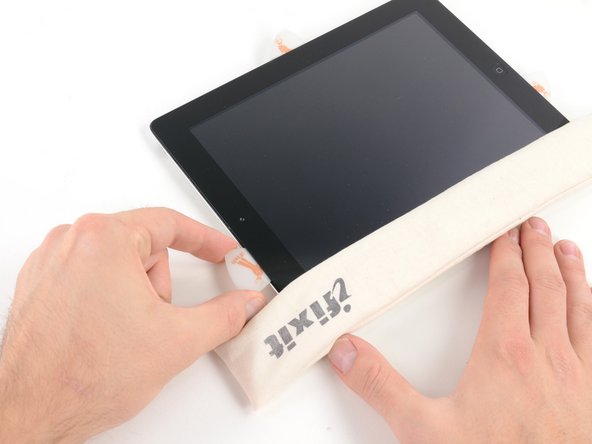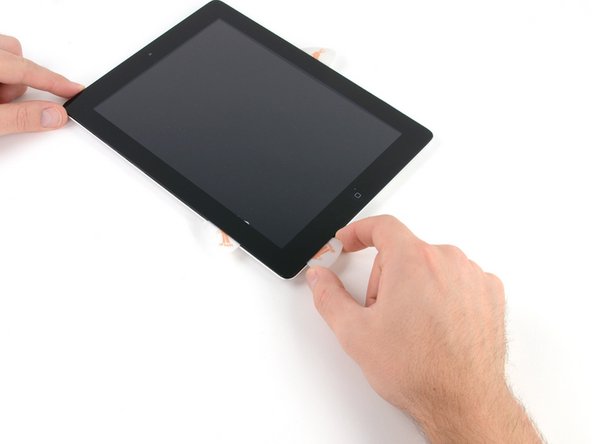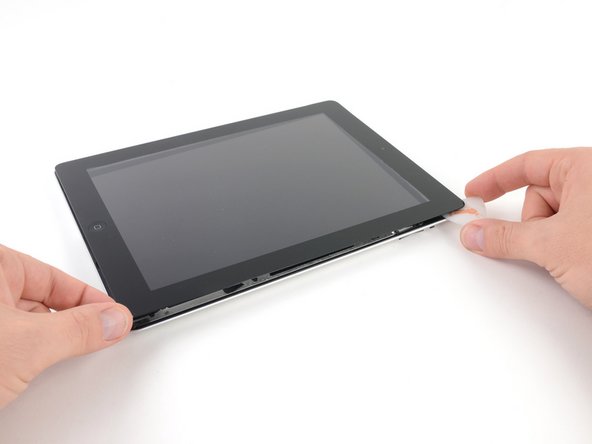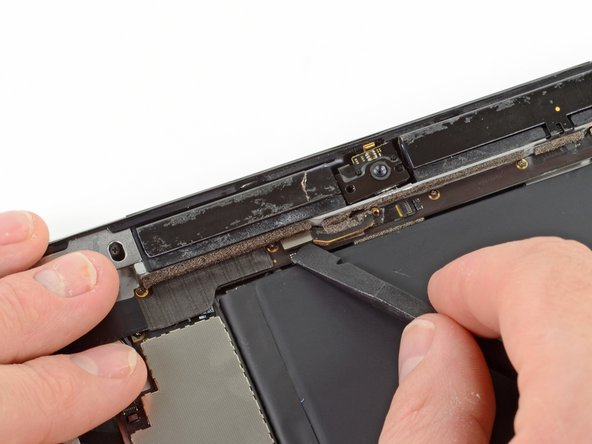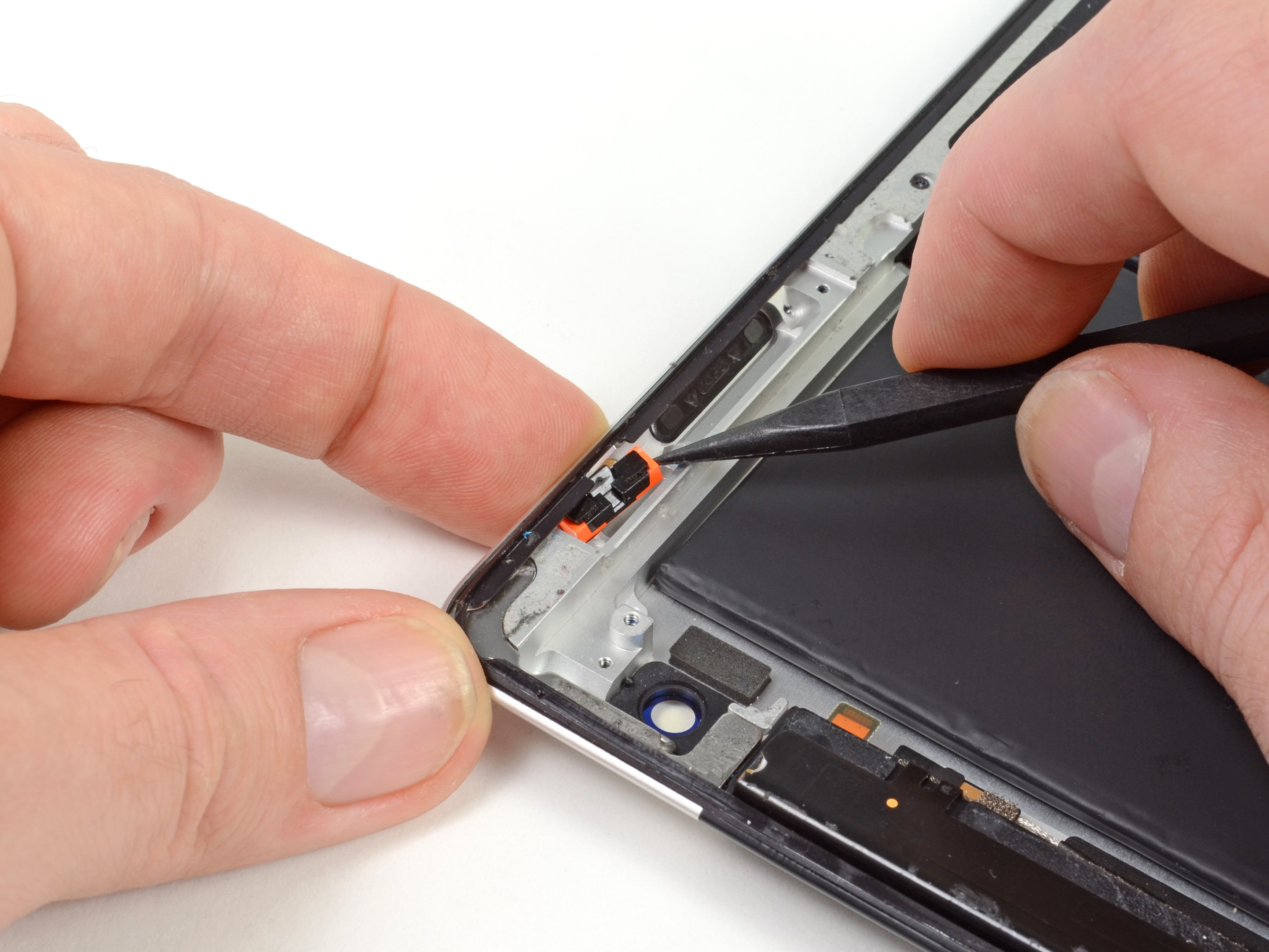iPad 3 4G Rear Facing Camera Replacement
Duration: 45 minutes
Steps: 55 Steps
To see or not to see? With the 5 MP camera on the third generation, skipping out on a working camera is definitely not the move. If your rear-facing camera is acting up, follow this guide to swap it out and keep your shots sharp.
Step 1
For carousel microwaves: Double-check that the plate spins without a hitch. If your iOpener gets stuck, it might overheat and cause a burn—so keep it moving!
Before diving in, let's give your microwave a little TLC! A quick clean will help ensure that any stubborn gunk on the bottom doesn't hitch a ride on your iOpener.
- Pop the iOpener right in the middle of the microwave to get it warmed up and ready to work its magic.
Tools Used
Step 2
Keep an eye on the iOpener while heating – don't let it get too hot! If it overheats, it could pop. Stick to a max of 100˚C (212˚F) for safety.
If the iOpener looks like it’s puffing up, don’t touch it. Seriously, give it space.
If it’s still too hot to handle, no worries – just let it cool down a bit before you reheat. A good iOpener should stay warm for up to 10 minutes, so you’ve got time.
Depending on your microwave's wattage, you might need to adjust the heating time a bit. The iOpener is ready to go when it’s just a tad too hot to handle comfortably.
- Pop the iOpener in the microwave for about 30 seconds to get it nice and warm.
- As you work through the repair, keep the iOpener nice and toasty by reheating it in the microwave for another 30 seconds when it cools down.
Tools Used
Step 3
The iOpener gets super toasty, so handle it with care! If it feels a bit too hot to handle, don’t hesitate to grab an oven mitt for some extra safety.
- Carefully take the iOpener out of the microwave, holding it by one of the two flat ends to keep your fingers safe from the hot center.
Tools Used
Step 4
The iOpener can get pretty hot, so make sure to only grab it by the end tabs to avoid any surprise burns!
Don't have a microwave? No worries! Just pot your iOpener in some boiling water to get it nice and toasty.
- Fill a pot or pan with enough water to completely submerge your iOpener.
- Heat the water until it starts boiling, then turn off the heat.
- Drop your iOpener into the hot water for 2-3 minutes. Make sure it’s fully submerged.
- Use tongs to carefully remove the heated iOpener from the water.
- Give the iOpener a good dry with a towel to remove any water.
- You're all set! If you need to heat the iOpener again, just repeat the process—bring the water to a boil, turn off the heat, and let the iOpener soak for another 2-3 minutes.
Tools Used
Step 5
- Grab a SIM eject tool or a straightened paperclip and give that SIM tray a gentle nudge to pop it out.
Step 6
- Gently slide the SIM tray out of its cozy little home on the iPad and give it a little wiggle to free it completely.
- If you're swapping in a shiny new SIM card, just pop the old one out of its tray and slide in the new one like a pro.
Step 7
Rock those safety glasses to keep your peepers safe, and remember to handle the LCD screen with care—it's more delicate than it looks!
This will help keep those pesky glass shards in check while also ensuring your display stays sturdy during the prying and lifting process.
- Got a cracked display glass? Keep the shards in check and avoid any ouch moments by taping up the glass first.
- Cover the iPad's screen with overlapping strips of clear packing tape until it's fully wrapped up.
- Follow the rest of the guide as best you can. Just a heads-up: once that glass is cracked, it might keep breaking as you go, so you might need to carefully use a metal prying tool to scoop it out.
Step 8
Just a heads up! You'll be dealing with some broken glass during this process, so it's a great idea to sport some safety glasses to protect those peepers from any pesky flying shards.
- Place the iOpener flat on the right edge of your iPad. Make sure it’s snugly positioned, so it can make solid contact with the iPad’s surface.
- Give it a good 90 seconds to do its thing before you try to pry open the front panel.
Tools Used
Step 9
It might take a little muscle to slide the wedged tip of your opening tool between the glass and plastic. Take your time, stay patient, and gently wiggle the tool back and forth as needed.
- Check out the tiny gap in the iPad’s adhesive ring at the upper right corner, about 2.0 inches (~5 cm) from the top. That’s your secret entry point.
- Line up your tool with the mute button. Gently slip the tip of a plastic opening tool into the crack between the front glass and the plastic bezel—just a little nudge to widen the gap, nothing crazy.
Step 10
- Place the tool carefully between the plastic display bezel and the front panel glass. It's a snug fit, so take your time and make sure everything lines up just right.
Step 11
- Gently tuck the tip of your plastic opening tool between the front glass and plastic bezel, then slide a plastic opening pick into the gap right next to it to carefully pry things open.
Step 12
- Take the plastic opening tool out of the iPad and gently slide the opening pick under the front glass. Aim to go about half an inch deep to give yourself some space to work with.
Step 13
- As you're gently working on loosening the adhesive on the right side of the iPad, give that iOpener a little reheat and then place it back on the bottom edge of the iPad. You've got this!
Tools Used
Step 14
The adhesive is super strong, so you might need to put in some elbow grease. Just take it slow and steady!
If you spot the tip of the opening pick peeking out from under the front glass, give it a gentle tug. While it's totally safe to use the pick this deep, it might leave some sticky adhesive marks on the LCD. Just a heads up!
- While the bottom edge is warming up with the iOpener, start working on loosening the adhesive from the right edge of the iPad.
- Gently slide the opening pick down along the iPad's edge, carefully releasing the adhesive as you go. Keep it steady and take your time!
Tools Used
Step 15
If the adhesive doesn't want to let go, you might need to pop the heated iOpener back on the right edge of the iPad while you gently release it. How long the iPad has been cooling off will help you decide if this step is necessary or not.
- If your opening pick seems to be playing hard to get with the adhesive, just give it a little 'roll' along the side of your iPad. Keep at it and you'll soon free up that sticky stuff like a pro!
Tools Used
Step 16
- Before you pop the first pick into the bottom corner of your iPad, sneak a second one under the right edge of the front glass. This keeps the adhesive from getting too clingy and reattaching itself.
- Give your iOpener another round of heat, then slide it to the top edge of the iPad. It’ll help loosen up that stubborn adhesive up there.
Tools Used
Step 17
The Wi-Fi antenna is snugly fastened to the bottom right corner of your iPad's rear case with screws and a cable. Given its unique position, it’s super important to tread carefully—otherwise, you might accidentally say goodbye to your Wi-Fi antenna. Let's keep it intact and safe!
- Alright, folks, it’s time to get a bit cautious for the next few steps!
- You'll need to carefully free the adhesive holding the antenna to the front panel, but be gentle – we don’t want to harm the delicate bits connecting the antenna to the bottom of the iPad. Follow these steps closely!
Step 18
Hey there! Just a quick heads-up: try not to slide the pick beyond the bottom right corner. You wouldn't want to accidentally mess with the Wi-Fi antenna, right?
- Gently slide the opening pick around the bottom right corner of your iPad. This will help you break the adhesive seal and get things moving.
Step 19
Careful now! Glide that opening pick along the bottom right edge of the front panel with style. The Wi-Fi antenna is chilling just around the corner and can be easily sliced if you’re too eager releasing the adhesive. Keep it smooth!
Just give that pick a little wiggle and don't pull it out all the way! Leave about 1/8" (3 mm) of the tip still cozy under the front glass for a smooth operation.
- Gently slide the tip of the opening pick along the bottom edge of your iPad to free up that adhesive near the Wi-Fi antenna. You're doing great!
Step 20
- After you pass the Wi-Fi antenna (about 3" or 75 mm from the right edge, right next to the home button), slide the opening pick all the way in.
- Gently slide the pick to the right to loosen the adhesive holding the Wi-Fi antenna to the front glass.
- The antenna is screwed and connected by a cable at the bottom of the iPad. This step frees the antenna from the front panel, so you won’t risk damaging it when removing the panel.
Step 21
Keep the iOpener's heating sessions to just a minute at a time, and give it a cool-off period of at least two minutes before you heat it up again. Your patience will pay off!
If the adhesive has cooled down too much along the bottom edge, just give the iOpener another warm-up session to get that adhesive nice and soft again where you're working.
- Keep on peeling that adhesive along the bottom of your iPad! Gently pull the opening pick out far enough to navigate around the home button. Once you're past the home button, reinsert the pick to a depth of about 1/2 inch (10 mm). You're doing great!
Tools Used
Step 22
When working on iPad 4 models, slide your pick in no more than 1/2 inch (10 mm) here to keep that home button ribbon cable safe and sound.
- Slowly peel back the adhesive along the bottom edge of the iPad. Take your time, you got this!
- Keep the opening pick tucked right under the front glass near the home button for now, it'll make your next move easier.
Step 23
- Pop your iOpener in the microwave for a quick reheat, then place it along the left edge of your iPad to get that adhesive warmed up in this section. Easy does it!
Tools Used
Step 24
If the adhesive has cooled down too much, pop the iOpener back along the top edge and keep at it. And if your iOpener gets cold on you, just give it another warm-up!
- Gently slide the opening pick along the top edge of your iPad, giving it a little nudge to get around the front-facing camera bracket.
- This section has some seriously strong adhesive, so you might need to use a bit more force. Take it slow and steady to avoid slipping and making any accidental messes on your iPad.
- If the opening pick is getting stuck in the adhesive, just roll it gently like shown in step 9 to keep things moving smoothly.
Tools Used
Step 25
If your adhesive is feeling nice and toasty, go ahead and take that iOpener off the iPad for a bit of ease. But if it's still pretty sticky, give the iOpener another quick heat-up and set it on the left edge while you get to work!
- Keep peeling away that adhesive along the top edge of your iPad, and gently maneuver the opening pick around the top left corner. You're doing great!
Tools Used
Step 26
The digitizer cable is hanging out about 2 inches (50 mm) up from the bottom of your iPad. When you’re sliding that pick, stop when you get about 2.25 inches (60 mm) from the bottom. You've got this!
- Gently glide the opening pick along the left edge of your iPad, letting it work its magic on the adhesive as you go. The adhesive here is quite thin thanks to the digitizer stretching across the entire left side. Just a heads up—keep the pick no deeper than ½ inch (10 mm) to avoid any accidental damage to the digitizer. You've got this!
Step 27
Heads up! The bottom of the digitizer cable is just about 1" (25 mm) from the iPad’s bottom edge. Take it slow and steady to avoid cutting this little guy!
- Slide the opening pick that’s chilling under the bottom edge of the iPad to gently free the adhesive at the bottom left corner.
Step 28
Sometimes, the adhesive around the edge of your iPad might get a little too cozy and stick back down. If you find yourself in this sticky situation, gently slide a pick under the edge where the front glass is still hanging on, and give that adhesive a little snip to free it up.
- Grab one of your opening picks and gently wedge it under the bottom right corner of the iPad, then use your fingers to lift it up like a pro.
Step 29
Watch out for any leftover adhesive! Use an opening pick to gently slice through any stubborn bits still holding the front panel in place.
- Grab the iPad by the top and bottom right corners and gently swivel the front glass away from the device.
- When putting it back together, give the LCD a good once-over with a microfiber cloth and a blast of compressed air to clear away any dust or smudges before snapping the glass back on.
Step 30
- Unscrew those four tiny 2 mm Phillips #00 screws that are holding the LCD snug against the aluminum frame. You've got this!
Step 31
Handle the LCD with care! That ribbon cable is a bit delicate and could snap if you flex it too much. Keep it cool and take your time!
- Grab a plastic opening tool or spudger and carefully lift the right edge of the LCD away from the iPad.
- Now, gently rotate the LCD along its left edge and lay it flat on the front panel. Easy does it!
Tools Used
Step 32
- Use the tip of your spudger to carefully lift the tape that's covering the LCD ribbon cable connector. Nice and easy, you got this!
Tools Used
Step 33
- Lift the retaining flap on the LCD ribbon cable ZIF connector with a gentle touch.
- Use your fingers or tweezers to carefully pull the LCD ribbon cable out of its slot on the logic board.
- If the LCD screen doesn’t light up after reconnecting the ZIF connector, try a force restart. Just hold down both the power button and home button for about ten seconds, and wait for the Apple logo to appear. If you're still stuck, don’t hesitate to schedule a repair.
Step 34
- Carefully lift the LCD away from the front panel without making contact with the screen. You've got this!
Step 35
- Grab your trusty spudger and gently lift that tape off the touchscreen ribbon cable that’s snug against the logic board. You've got this!
Tools Used
Step 36
- Lift the retaining flap on both of the ZIF connectors for the touchscreen ribbon cable.
Step 37
- Grab your trusty spudger and gently slide the flat end under the digitizer ribbon cable to break free the adhesive holding it down.
- Once it's loosened up, pull the digitizer ribbon cable straight out of its sockets on the logic board. Easy peasy!
Tools Used
Step 38
- Gently lift the touchscreen ribbon cable and use the flat end of a spudger to carefully pop loose the adhesive holding the cable to the back aluminum case.
Tools Used
Step 39
- Gently wiggle and pull the touchscreen ribbon cable free from its snug spot in the aluminum frame using your fingers.
- Lift the front panel off the iPad carefully.
Step 40
- Gently peel away the electrical tape that's cozily hugging the headphone jack assembly cable connector. Out it goes!
- With the pointy end of your spudger, lift up the retaining flaps on both ZIF connectors that are holding the headphone jack cable tight to the logic board. You've got this!
Tools Used
Step 41
- Carefully slide the flat end of your spudger under the headphone jack assembly cable to gently free the adhesive sticking it to the rear aluminum frame.
- Gently pull the headphone jack assembly cable straight out from its socket on the logic board.
Tools Used
Step 42
- Gently lift and peel away the tape that's hiding the SIM board cable ZIF connector.
- Flip up the little latch on the SIM board cable ZIF connector to unlock it.
- Carefully use a spudger tip to pull the SIM board cable straight out from its socket on the logic board.
Tools Used
Step 43
- Unscrew the three 1.75 mm Phillips #00 screws that are holding the SIM board in place on the aluminum frame. Easy does it—these screws are the only thing standing between you and the next step!
Step 44
As you gently move the headphone jack assembly cable aside, remember to take it easy on the headphone jack itself—yanking too hard might just send it flying off!
- Carefully move the headphone jack assembly cable to the side, then gently remove the SIM board from your iPad.
Step 45
- Gently peel away the adhesive tape that’s keeping the headphone jack assembly snug and secure. You've got this!
Step 46
- Let's get started by taking out that pesky little 2.6 mm Phillips #0 screw that's holding the camera cable snugly against the headphone jack assembly. You've got this!
Step 47
- Grab the flat end of your spudger and gently pry the front-facing camera away from its cozy home on the headphone jack assembly.
- Keep the spudger in place and slide it to the right, giving the camera cable a little nudge to release it from the adhesive's grip.
Tools Used
Step 48
- Gently use the spudger tip to lift the little flap holding the microphone cable's ZIF connector in place.
- Slide the spudger under the microphone ribbon cable and carefully pop it out of its connector.
- Move the spudger to the left to free the adhesive that’s keeping the microphone ribbon cable stuck to the headphone jack assembly.
Tools Used
Step 49
- Using the flat end of your spudger, gently lift the antenna connector cable out of its cozy home on the headphone jack assembly board. You've got this!
Tools Used
Step 50
- Lift up the little flap that's holding the volume/power button ribbon cable in place on the headphone jack assembly board. You've got this!
- Gently disconnect the volume button ribbon cable from its ZIF connector. Easy peasy!
Step 51
These screws are angled into the aluminum frame. Make sure you align the screwdriver with the screw to avoid stripping it. Keep your aim true and steady!
- Let's get those screws out of the headphone jack assembly! First up, grab your trusty screwdriver and remove these little guys:
- Five 2.6 mm Phillips #0 screws
- Two 2.2 mm Wide Head Phillips #00 screws
- And lastly, two 2.6 mm Phillips #00 screws
- You're doing great—keep it up!
Step 52
- With a gentle grip on the ribbon cable of the headphone jack assembly, smoothly pull the assembly parallel to the iPad and toward the bottom of the device. You're doing great!
Step 53
- Hold the headphone jack assembly firmly with both hands and gently pull it out of the iPad, keeping an eye out for any cables that might be hanging around.
Step 54
- With the flat end of your trusty spudger, gently pop the rear-facing camera out of its snug little home on the underside of the headphone jack assembly board. You've got this!
Tools Used
Step 55
- Now it’s time to put everything back together! Just work your way through those steps in reverse, and you'll be back in action in no time. If you hit a snag, don’t hesitate to schedule a repair with us. You've got this!




























